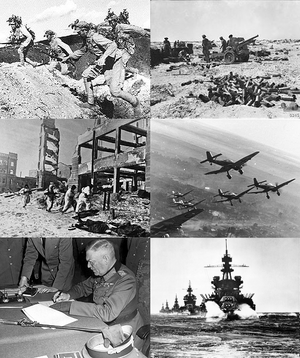World War II/Infobox
Appearance
| World War II |
|---|
| Navigation |
|
|
References
- Footnotes
- ^ 23 August 1939, the USSR and Germany sign non-aggression pact, secretly dividing Eastern Europe into spheres of influence. USSR armistice with Japan 16 September 1939; invades Poland 17 September 1939; attacks Finland 30 September 1939; forcibly incorporates Baltic States June 1940; takes eastern Romania 4 July 1940. 22 June 1941, USSR is invaded by European Axis; USSR aligns with countries fighting Axis.
- ^ After the fall of the Third Republic in 1940, the de facto government was the Vichy Regime. It conducted pro-Axis policies until November 1942 while remaining formally neutral. The Free French Forces, based out of London, were recognized by all Allies as the official government in September 1944.

